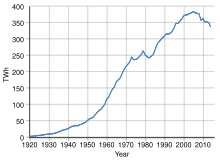| Data | |
|---|---|
| Electricity coverage | 100% (91.8% grid 2017[1]) |
| Continuity of supply | 99.9999% |
| Installed capacity | 74.8 GW (2023) [2] |
| Production | 292.7 TWh (2023)[2] |
| Share of fossil energy | 36.65% (2023)[2] |
| Share of renewable energy | 46.39% (2023)[2] |
| GHG emissions from electricity generation (2020) | 181 t CO2 per GWh[3] |
| Average electricity use (2023) | 3,239 kWh/person |
| Transmission & Distribution losses (2017) | 7.5% |
| Institutions | |
| Responsibility for regulation | Office of Gas and Electricity Markets |
| Responsibility for policy-setting | Parliament of the United Kingdom |
| Electricity sector law | Electricity Act 1989 |

This article needs to be updated. The reason given is: more on path to net zero in 2035 from https://www.theccc.org.uk/2023/03/09/a-reliable-secure-and-decarbonised-power-system-by-2035-is-possible-but-not-at-this-pace-of-delivery/ already cited. (April 2024) |
The National Grid covers most of mainland Great Britain and several of the surrounding islands, and there are interconnectors to Northern Ireland and to other European countries. Power is supplied to consumers at 230 volts AC with a frequency of 50 Hz. In 2023 about a third of electricity used in Britain was generated from fossil gas and two-thirds was low-carbon power. Wind generates the most low-carbon power, followed by nuclear some of which is imported from France.[5] The government is aiming for greenhouse gas emissions from electricity in Britain to be net zero by 2035.[6]
The use of electricity declined in the 2010s and early 2020s, attributed largely to a decline in industrial activity and a switch to more energy efficient lighting and appliances.[7] However demand is projected to increase considerably due to electrification, such as heat pumps[8] and electric vehicles.[9]
UK energy policy includes capping some residential energy price rates,[10] and wholesale prices for some new low-carbon power can be stabilized by the government.[11]
Nationalisation plans are currently underway following the proposed introduction of Great British Energy subsequent to the 2024 King's Speech, which also oversaw increased dedication towards net-zero targets by 2050. This is further emphasised via GB Energy through heavy investment in renewable energy sources, such as tidal power and offshore windfarms. The future body also intends to operate and manage clean power projects at a state level, in contrast with private entities having done so for several years.
Under the most recent estimates, the plan will amount to £8bn. for the government, a figure criticised by the opposition and media alike, although Energy Secretary Ed Miliband has claimed it will have an environmental impact in forwarding sustainability, as well as predicting that it will reduce average electricity thresholds by £1,400 universally. The entity will remain in preliminary stages before implementation of the Great British Energy Bill, whereupon it shall be established after royal assent given in accordance with the law of the United Kingdom.
- ^ "Digest of UK Energy Statistics (DUKES): electricity". GOV.UK. 27 July 2023.
- ^ a b c d "Digest of UK Energy Statistics (DUKES) 2024: Chapters 1 to 7". GOV.UK. 30 July 2024.
- ^ Cite error: The named reference
ESO2020bwas invoked but never defined (see the help page). - ^ "Digest of UK energy statistics: 60th Anniversary Report". Retrieved 16 December 2013.
- ^ Evans, Simon (3 January 2024). "Analysis: UK electricity from fossil fuels drops to lowest level since 1957". Carbon Brief. Retrieved 21 April 2024.
- ^ Dooks, Tom (9 March 2023). "A reliable, secure and decarbonised power system by 2035 is possible – but not at this pace of delivery". Climate Change Committee. Retrieved 21 April 2024.
- ^ Cite error: The named reference
guardian-20180130was invoked but never defined (see the help page). - ^ "Heating Could Add 5% to U.K. Electricity Demand in 2030". BloombergNEF. 16 February 2021. Retrieved 21 April 2024.
- ^ "UK Electricity Demand to Double by 2050, Urgent Action Needed for Net Zero Transition". Dalcour Maclaren. Retrieved 21 April 2024.
- ^ "Energy price cap | Ofgem". www.ofgem.gov.uk. Retrieved 22 April 2024.
- ^ "Contracts for Difference" (PDF).